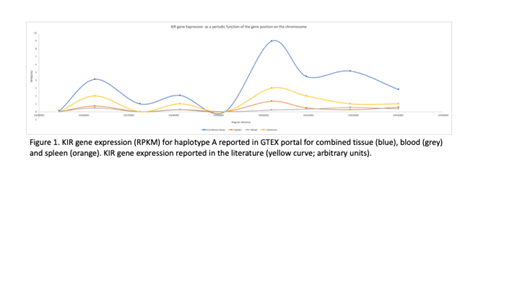Killer Immunoglobulin Like Receptors (KIR) are expressed on natural killer (NK) and T cell surface. KIR interactions with KIR-ligands have been implicated in outcomes of hematopoietic stem cell transplantation, placental implantation, autoimmune disease and viral infections. While these KIR interactions are clearly important our understanding of what governs their expression is lacking. The KIR Locus is made up of a highly polymorphic and homologous set of genes located on Chromosome 19q13.4 within the leukocyte receptor complex. Unique to the KIR Gene Cluster, KIR haplotypes not only vary allelically, but they also differ in the number of KIR genes present in different individuals, ranging from 7 to 12 genes. KIR haplotypes have been divided into 2 broad groups; Haplotypes A & B, based on the number of activating and inhibitory KIR genes they possess; where haplotype A contains only one activating allele KIR2DS4 and haplotype B contains various combinations of activating alleles. Expression of KIR on the NK cell surface stochastic, with some KIR found more commonly then others. In this abstract we aim to explore the relationship of KIR gene expression and the organization of the KIR gene locus using available genomic and tissue expression data.
KIR gene coordinates on chromosome 19 were collected using the UCSC Genome Browser GRCh38/hg38 gene assembly and the NCBI gene website gene assembly NC_000019.10. Initial KIR gene nucleotide position along chromosome 19 were obtained and converted to angular distance (A.D. in radians) from reference. This was done to account for the double helical nature of DNA molecules, using the following equation A.D. = 2px/10.4; where x is the initial KIR gene nucleotide coordinate. Haplotype A was utilized as an initial test case as gene expression data are available for the genes in this haplotype. GTEX Portal was used to collect mRNA expression for each of the haplotype A genes, KIR-2DL1, -2DL3, -2DL4, -2DP1, -2DS4, -3DL1, -3DL2, -3DL3 & -3DP1, including total (median), splenic and whole blood expression in Reads/Kilobase of transcript/million mapped reads (RPKM). Gene expression was determined via RNA-seq of 53 tissues from 570 donors.
KIR haplotype A is located along chromosome 19 between nucleotide position 55,236,713 and 55,370,584 which corresponded with an A.D. of 33,354,476 to 33,435,314 radians. When the KIR gene expression was aligned with the coordinates of the corresponding gene on the KIR locus a distinct periodic pattern of variation in expression levels was observed across the KIR genes comprising Haplotype A (Figure 1). This was true for total KIR expression from across various organs, as well as in blood and splenic tissue. This is borne out by expression data on several Haplotype A KIR genes reported in the literature (Figure 1, yellow curve).
These observations suggesting that KIR gene expression may be a periodic function of the gene coordinates on the chromosome are analogous to the periodicity observed in T cell receptor VDJ recombination (Meier et al, BBMT 2019 25(5);868). This observation supports the idea that the spiral structure of the helical DNA molecules coiled around the histone molecules and their arrangement on chromosomes may have a fundamental influence on the expression of different genes, perhaps in conjunction with known epigenetic influence of DNA methylation and histone acetylation. This may also point to a role for the non-coding DNA in regulation of gene expression. We posit that the helical DNA chromosome structure may have a fundamental role in determining gene expression, as exemplified by the KIR and T cell receptor gene loci. This knowledge may allow an improved understanding of variability in global gene expression.
No relevant conflicts of interest to declare.
Author notes
Asterisk with author names denotes non-ASH members.


This feature is available to Subscribers Only
Sign In or Create an Account Close Modal